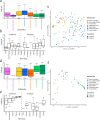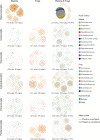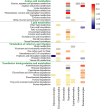Symbiotic Microorganisms and Their Different Association Types in Aquatic and Semiaquatic Bugs
- PMID: 36409137
- PMCID: PMC9769989
- DOI: 10.1128/spectrum.02794-22
Symbiotic Microorganisms and Their Different Association Types in Aquatic and Semiaquatic Bugs
Abstract
True bugs (Hemiptera, suborder Heteroptera) constitute the largest suborder of nonholometabolous insects and occupy a wide range of habitats various from terrestrial to semiaquatic to aquatic niches. The transition and occupation of these diverse habitats impose various challenges to true bugs, including access to oxygen for the aquatic species and plant defense for the terrestrial phytophagans. Although numerous studies have demonstrated that microorganisms can provide multiple benefits to terrestrial host insects, a systematic study with comprehensive higher taxa sampling that represents aquatic and semiaquatic habitats is still lacking. To explore the role of symbiotic microorganisms in true bug adaptations, 204 samples belonging to all seven infraorders of Heteroptera were investigated, representing approximately 85% of its superfamilies and almost all known habitats. The symbiotic microbial communities of these insects were analyzed based on the full-length amplicons of the bacterial 16S rRNA gene and fungal ITS region. Bacterial communities varied among hosts inhabiting terrestrial, semiaquatic, and aquatic habitats, while fungal communities were more related to the geographical distribution of the hosts. Interestingly, co-occurrence networks showed that species inhabiting similar habitats shared symbiotic microorganism association types. Moreover, functional prediction analyses showed that the symbiotic bacterial community of aquatic species displayed richer amino acid and lipid metabolism pathways, while plant-feeding true bugs benefited more from the symbiont-provided xenobiotics biodegradation pathway. These results deepened the recognition that symbiotic microorganisms were likely to help heteropterans occupy diverse ecological habitats and provided a reference framework for further studies on how microorganisms affect host insects living in various habitats. IMPORTANCE Symbiotic bacteria and fungi generally colonize insects and provide various benefits for hosts. Although numerous studies have investigated symbionts in terrestrial plant-feeding insects, explorations of symbiotic bacterial and fungal communities in aquatic and semiaquatic insects are rare. In this study, the symbiotic microorganisms of 204 aquatic, semiaquatic, and terrestrial true bugs were explored. This comprehensive taxon sampling covers ~85% of the superfamilies of true bugs and most insect habitats. Analyses of the diversity of symbionts demonstrated that the symbiotic microbial diversities of true bugs were mainly affected by host habitats. Co-occurrence networks showed that true bugs inhabiting similar habitats shared symbiotic microbial association types. These correlations between symbionts and hosts together with the functions of bacterial communities indicated that symbiotic microbial communities may help true bugs adapt to (semi)aquatic habitats.
Keywords: Heteroptera; aquatic/semiaquatic bugs; co-occurrence network; diverse habitats; symbiotic microorganism.
Conflict of interest statement
The authors declare no conflict of interest.
Figures





Similar articles
-
Different roles of host and habitat in determining the microbial communities of plant-feeding true bugs.Microbiome. 2023 Nov 7;11(1):244. doi: 10.1186/s40168-023-01702-y. Microbiome. 2023. PMID: 37932839 Free PMC article.
-
The Impact of Environmental Habitats and Diets on the Gut Microbiota Diversity of True Bugs (Hemiptera: Heteroptera).Biology (Basel). 2022 Jul 11;11(7):1039. doi: 10.3390/biology11071039. Biology (Basel). 2022. PMID: 36101420 Free PMC article.
-
Phylogenetic Evidence for Ancient and Persistent Environmental Symbiont Reacquisition in Largidae (Hemiptera: Heteroptera).Appl Environ Microbiol. 2016 Nov 21;82(24):7123-7133. doi: 10.1128/AEM.02114-16. Print 2016 Dec 15. Appl Environ Microbiol. 2016. PMID: 27694238 Free PMC article.
-
Symbiotic factors in Burkholderia essential for establishing an association with the bean bug, Riptortus pedestris.Arch Insect Biochem Physiol. 2015 Jan;88(1):4-17. doi: 10.1002/arch.21218. Arch Insect Biochem Physiol. 2015. PMID: 25521625 Review.
-
The Role of Bacterial Symbionts in Triatomines: An Evolutionary Perspective.Microorganisms. 2020 Sep 19;8(9):1438. doi: 10.3390/microorganisms8091438. Microorganisms. 2020. PMID: 32961808 Free PMC article. Review.
Cited by
-
Influence of Host Species, Location, and Aphid Prey on Microbial Diversity and Community Dynamics of Aphidophagous Ladybird Beetles in Guangxi, China.Ecol Evol. 2025 Feb 20;15(2):e71036. doi: 10.1002/ece3.71036. eCollection 2025 Feb. Ecol Evol. 2025. PMID: 39991448 Free PMC article.
-
Microbial diversity and functional potential of the Halobates melleus (Heteroptera: Gerridae) microbiome from the Red Sea coastline.Environ Microbiome. 2025 Aug 8;20(1):103. doi: 10.1186/s40793-025-00761-y. Environ Microbiome. 2025. PMID: 40781723 Free PMC article.
References
-
- Henry TJ. 2017. Biodiversity of heteroptera. In Foottit RG, Adler PH (ed), Insect biodiversity: science and society. Volume I, Second Edition. Wiley-Blackwell, WarnockPro by SPi Global, Chennai, India.
-
- Schuh RT, Weirauch C. 2020. True bugs of the world (Hemiptera:Heteroptera) classification and natural history. Siri Scientific Press, Manchester, UK.
-
- Stys P, Kerzhner I. 1975. The rank and nomenclature of higher taxa in recent Heteroptera. Acta Entomologica Bohemoslovaca 72:65–79.
Publication types
MeSH terms
Substances
LinkOut - more resources
Full Text Sources

